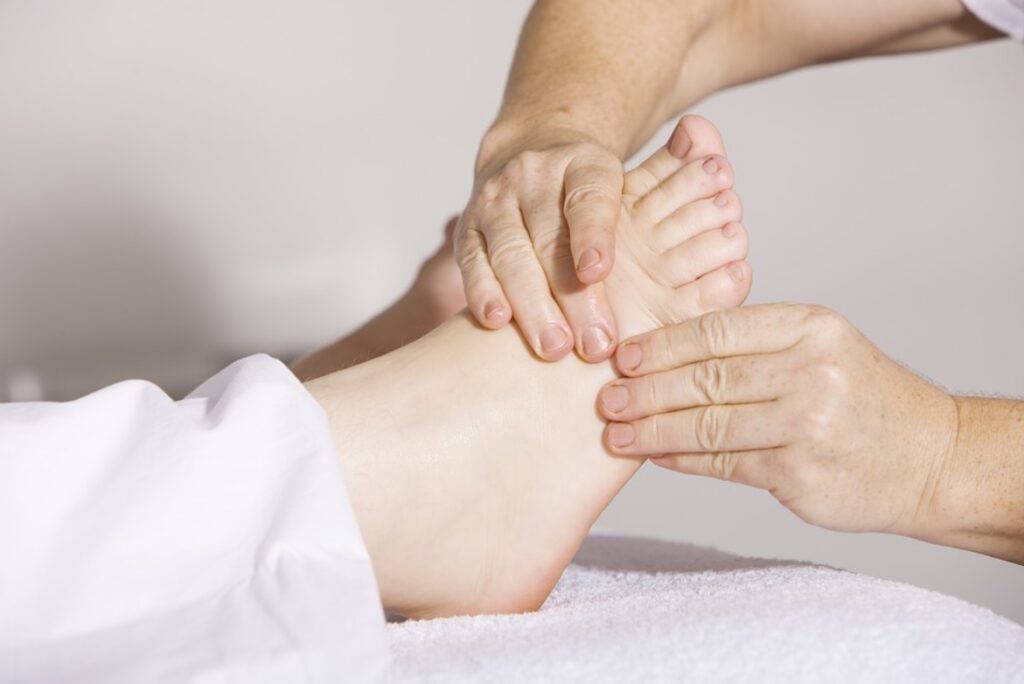People experiencing persistent foot pain may be dealing with Morton’s neuroma, a condition characterized by sharp pain beneath the feet. Many describe the discomfort as a stabbing, burning sensation, similar to walking on pins and needles or having a pebble trapped in a shoe.
Understanding Morton’s neuroma is important as many adults experience foot pain at some point in their lives. This article aims to clarify this often-misunderstood foot ailment, offering insights into its causes, symptoms, and the raft of treatment options available to those afflicted.
Understanding Morton’s Neuroma
A. Definition and Causes
Morton’s neuroma is a condition that affects the nerves in your foot, particularly between the third and fourth toes. This thickening of the nerves can lead to inflammation and pain. But what causes it?
Nerve Irritation
Nerve irritation in the foot can lead to Morton’s neuroma. The nerves, when persistently agitated or pressured, could swell and thicken. Many people experience nerve irritation due to various factors, including unsupportive footwear and specific physical activities. For instance, frequent and prolonged walking or standing, especially in unsupportive footwear, can exacerbate the situation.
Consulting a podiatrist can clarify the type and cause of nerve irritation. They’ll assess the severity of your symptoms, explore underlying issues, and suggest appropriate treatments.
Compression
Compression is another leading cause. Shoes that are too tight, high-heeled, or lack support can exert pressure on the nerves between the toes. This ongoing compression can lead to the development of Morton’s neuroma, characterized by a thickening of the nerve tissue.
Choosing footwear that provides adequate space and support is essential to avoid nerve compression. Paying attention to early signs of discomfort and making informed choices in footwear can mitigate the risk of developing this painful condition.
Injury
Injuries to the foot, whether acute or due to repetitive stress, may precipitate Morton’s neuroma. Direct trauma could lead to an inflammatory response, causing the nerves to thicken and pain to ensue. It’s your body’s natural reaction that could result in chronic discomfort if not addressed.
Managing foot injuries with prompt medical attention and appropriate care is vital. Healing and rehabilitation strategies can prevent the onset of complications like Morton’s neuroma.
Incorrect Walking Style
An incorrect walking style is an overlooked yet significant contributor to Morton’s neuroma. Putting excessive pressure on the forefoot or having an irregular gait can increase strain on the foot’s nerves. Over time, this may cause them to become inflamed.
Identifying and correcting your walking style could help. Various therapies and interventions aid in realigning the gait and distributing pressure evenly across the foot, reducing the risk of nerve damage.
Awkward Foot Structure
Some individuals have a natural foot structure predisposing them to issues like Morton’s neuroma. For example, a higher arch or flat feet could result in an unequal weight distribution, increasing pressure on specific foot areas.

Addressing these structural issues with appropriate footwear and orthotic supports can help redistribute pressure effectively. Customized solutions can alleviate pain and prevent the progression of Morton’s neuroma.
Hypermobility
Hypermobility, a condition where joints move beyond the normal range, may also contribute to the development of Morton’s neuroma. Excessive movement could lead to an increased strain on the foot’s nerves.
For hypermobility, focus on exercises and supportive footwear to limit excessive joint movements. The goal is to reduce nerve strain and pressure, preventing inflammation and pain.
B. Symptoms and Diagnosis
Individuals with Morton’s neuroma typically describe various symptoms. It starts with sharp pain, usually between the toes, which might be mistaken for regular foot soreness. Aside from pain, you might experience the following:
Tingling
Tingling sensations are common and can be unsettling. It’s a precursor to pain and indicates that the nerve is affected. This sensation can be sporadic or persistent, varying in intensity.
Recording how often and intensely the tingling occurs can assist in diagnosis. It’s one of the aspects that healthcare professionals will inquire about to understand the progression and severity of Morton’s neuroma.
Numbness
Numbness in the ball of the foot or toes is another symptom. It can create a feeling of weakness or instability while walking. Numbness might indicate nerve compression and should be addressed promptly to prevent worsening the condition.
Medical evaluations will consider the extent of numbness. Detailed assessments are used to understand the extent of numbness, pinpoint affected nerves, and determine the severity of compression. These insights contribute to a comprehensive diagnosis and inform the appropriate treatment plan.
Burning Sensation
A burning sensation is another telltale sign of Morton’s neuroma. It can be particularly intense after long periods of walking or standing and is often accompanied by increased temperature in the affected area.
Identifying triggers and patterns of the burning sensation can be instrumental in diagnosis and treatment. Interventions often aim to alleviate this uncomfortable sensation, enhancing comfort and mobility.
Cramping
Cramping in the foot, especially after extended periods of activity, is a common complaint. It reflects the muscles’ response to nerve irritation and can be debilitating.
Addressing cramping involves both symptom management and underlying cause resolution. It’s a multifaceted approach that combines pain relief with strategies to alleviate nerve compression and irritation.
Feeling Like There’s a Pebble in Your Shoe As You Walk
This peculiar sensation is characteristic of Morton’s neuroma. It’s not just a passing feeling but a persistent sensation affecting walking and foot health.
Healthcare professionals often look for this specific symptom to diagnose Morton’s neuroma. Understanding its frequency and intensity is essential in assessing the condition’s severity and determining the appropriate course of treatment.
When you visit a podiatrist, they’ll first discuss your symptoms and medical history. A physical examination helps them feel for any tender spots or nerve thickening. They might also order imaging tests, like X-rays or MRI scans, to get a detailed look at your foot structure and rule out other potential causes.
IV. Risk Factors
Certain groups are more vulnerable to developing Morton’s Neuroma. Individuals frequently wearing tight, narrow, or high-heeled shoes can be more susceptible to this condition. The design of these shoes places excessive pressure on the forefoot, escalating the risk of nerve compression and irritation. More than a fleeting discomfort, it can develop into a chronic, painful condition requiring medical intervention.
Athletes and those involved in high-impact sports are also at risk. The repetitive stress and pressure on the foot, combined with specific types of footwear, can sometimes accelerate the onset of Morton’s Neuroma. Awareness of these risk factors and taking preventative measures is not just a proactive approach—it’s necessary to ensure long-term foot health and comfort.
Treatment Options
A. Non-Surgical Treatments
Numerous non-surgical treatment options are available for those diagnosed with Morton’s neuroma. Here’s a list to consider:
Wearing Roomier Shoes
The proper footwear can significantly ease symptoms and prevent their escalation. It reduces pressure on the compressed nerve, alleviating pain.
Exploring various brands and styles to find the perfect fit is worth the effort. Comfortable and supportive shoes are essential in managing and alleviating symptoms.
Using Orthotics
Custom orthotics can be a game-changer. These devices offer targeted cushioning and support to alleviate pressure on the affected nerves. Orthotics can provide relief and promote optimal foot alignment.
Regular consultations allow healthcare professionals to monitor the patient’s overall condition, assess the effectiveness of treatments including orthotics, and make necessary adjustments for optimal relief and healing. It provides ongoing support that adapts to the changing needs of your foot health.

Applying Ice Packs or Metatarsal Pads
Ice packs can temporarily alleviate pain during acute flare-ups. They are a supplemental measure to provide comfort alongside the primary treatment plan. On the other hand, metatarsal pads offer targeted support, reducing pressure on the affected nerve.
Incorporating these into your daily routine may help. Consistency in application and use could result in sustained relief, making everyday activities more manageable and comfortable.
Taking Over-the-Counter Pain Relievers
These medications can be effective in managing acute pain and inflammation. They offer immediate relief, making moving and carrying on with daily activities easier.
However, it’s essential to use them judiciously and consult a healthcare professional for the appropriate dosage and duration. Long-term use should be avoided unless recommended, as it can lead to other health complications.
Wrapping the Foot with Athletic Tape
Athletic tape provides additional support and stability. It helps redistribute pressure across the foot, alleviating strain on the affected nerve. It’s a non-invasive intervention that can particularly benefit individuals on their feet often.
Undergoing Physical Therapy
As part of a comprehensive treatment plan, physical therapy includes exercises and strategies designed to relieve pain and enhance foot functionality. Therapists assess your condition and develop a tailored approach to address the underlying issues contributing to Morton’s neuroma.
Modifying Physical Activities
Sometimes, a reassessment and modification of your physical activities can alleviate symptoms. Avoiding high-impact or repetitive activities that exacerbate nerve compression and irritation can lead to significant relief. Implementing these modifications requires understanding the triggers and actions that aggravate your symptoms.
B. Surgical Interventions And Invasive Approaches
If non-surgical methods don’t help, don’t worry; there are more intensive treatments you can explore:
Dorsal Approach
This procedure involves creating an incision on the top of the foot to access and address the affected nerve. It’s considered when non-invasive treatments aren’t effective. The recovery period is relatively quicker, as weight-bearing on the sole isn’t affected post-surgery.
Plantar Approach
Unlike the dorsal approach, this procedure involves an incision on the sole. It allows direct access to the affected nerve but can result in a longer recovery period as doctors advise patients to limit weight-bearing activities post-surgery.
Nerve Decompression
The nerve decompression procedure releases the structures compressing the nerve to alleviate pressure. It’s less invasive than nerve removal and focuses on preserving the nerve while addressing the root cause of compression and pain.
Nerve Removal
In severe cases, removing the affected nerve might be necessary. While it provides immediate relief from neuralgia, it may permanently numb the affected area. It’s a last resort, which you must only consider when other treatments fail to provide relief.
Radiofrequency Ablation
This procedure uses radio waves to generate heat, targeting and disrupting the affected nerve’s ability to transmit pain signals. It’s minimally invasive and can provide significant relief for an extended period.
Cortisone Injection
Cortisone injections deliver a potent anti-inflammatory medication directly to the affected nerve. It can provide immediate and significant relief from inflammation and pain. However, the relief might be temporary, and there can be limits on the number of injections you can receive due to potential side effects.
Always consult with a medical professional when deciding on treatment. They’ll guide you to the best option for your specific situation.
Prevention Strategies
Taking steps to prevent Morton’s Neuroma centers primarily on foot care and appropriate footwear. Shoes with a broad toe area and low heels can reduce pressure on the front of the foot, mitigating the risk of nerve compression and irritation. Similarly, avoiding tight, narrow shoes or those with high heels can significantly reduce the chances of developing this painful condition.
Incorporating specific exercises to strengthen the foot muscles can also be beneficial. These exercises, often simple and easy to integrate into your daily routine, improve foot stability and structure, reducing undue pressure on the nerves. Adopting a habit of foot massages and stretches can improve circulation and flexibility, further supporting foot health and minimizing the risk of conditions like Morton’s Neuroma.
Living With Morton’s Neuroma
Living with this condition requires a mix of medical treatments and self-care to manage pain and symptoms. It’s essential to adhere to the prescribed treatment regimen, whether it involves medication, physical therapy, or lifestyle modifications. Timely medical check-ups ensure that the treatment aligns with your evolving needs and that you promptly address any emerging issues.
Daily self-care is equally vital. It includes choosing proper footwear to reduce pressure on the affected area, allowing the inflamed nerve to heal. Resting the foot, applying ice for pain relief, and avoiding activities that exacerbate the symptoms can contribute to managing the condition effectively.
Conclusion
Though Morton’s neuroma is associated with persistent pain, it is manageable. With the right information, treatment, and support, individuals can effectively manage symptoms and lead an active, comfortable life. Each step towards relief involves informed decisions about treatment and self-care.
